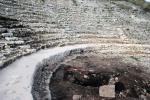Summary (English)
This was the sixth campaign on the theatre-temple complex (9th October-16th November)
The aims were to re-organise the logistical structures and the excavation area; continue excavations in the ima cavea, and the restoration of the recently exposed walls.The excavations completely exposed tiers n. 9 and 10. These were in a good state of preservation and like the other structures were built of irregularly shaped limestone chips bonded with mortar.
Once the level of the 2012 excavations was reached a new trench was opened to evaluate the depth of soil still covering the orchestra floor. This was c. 1 × 2 m and aligned east-west , in the western part of the cavea. A further three tiers of the ima cavea were uncovered (11, 12, 13) and the opus signinum orchestra floor was also exposed.The remaining stretch of the diàzoma, excavated and restored in 2012, was exposed. It was seen that the present ground level in the ima cavea is about one metre above the orchestra’s original floor level. Therefore, to uncover that level across the whole of the southern part of the theatre would require the removal of about 190 m3 of soil.
The restoration undertaken in 2012 had survived the winter without any major signs of damage. The decision not to treat the mortar with protective resin had only caused about a 1 mm thickness of the surface film to come away.
The 2013 restorations involved the floor surface of the diàzoma and the adjustment of the height of the parados wall to the level excavated in the media cavea. The building materials used were all recovered from the excavations, and the mortar made up of 30% of bonding material (slaked lime and Lafarge in a 2:1 ratio) and 69% of coarse limestone sand. In order to guarantee the hydraulic properties of the mix a small percentage (1%) of brick dust (grain size 1-4 mm), as was the case in antiquity. The actual floor surface was sponged to improve the aesthetics of the restoration.
- Gianluca Tagliamonte - Università del Salento
Director
- Gianluca Tagliamonte
Team
- Antonella Natali – Università del Salento
- Dario Panariti – Università del Salento
- Luigi Cinque – Università del Salento
- Luciano M. Rendina
Research Body
Funding Body
- Comune di Pietravairano.
- Università del Salento






![Download [PDF]](/excavation/skins/fasti/images/results/download_sml.png)


